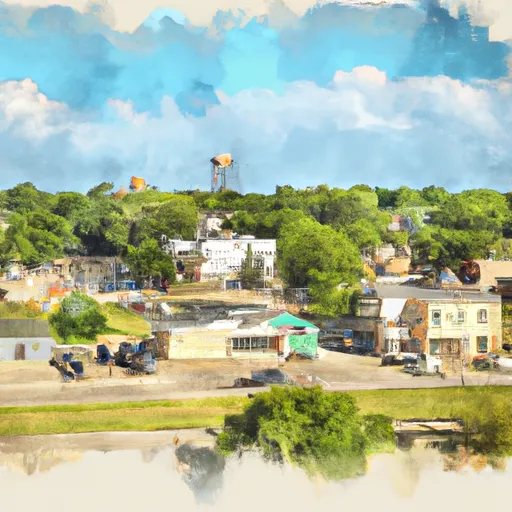-
 Snoflo Premium
Snoflo Premium
Get unlimited access to all our content
With no Ad interruptions! - Start Your Free Trial Login with existing account
Sharon-Springs
Eden Index
Climate
9.3
•
Recreation
•
Community
1.7
•
Safeguard
4.2/10

Sharon Springs, Kansas is a small town located in Wallace County in the western part of the state. The town experiences a semi-arid climate, characterized by hot summers and cold winters. Average high temperatures range from the mid-90s Fahrenheit (mid-30s Celsius) in summer to the mid-40s Fahrenheit (around 10 degrees Celsius) in winter. Precipitation is limited, with an average annual rainfall of around 20 inches (50 centimeters), and snowfall is minimal.
Hydrologically, Sharon Springs is part of the Smoky Hill River Basin, with the Smoky Hill River passing through the county. However, due to the arid climate, water resources are scarce, and the region depends heavily on groundwater for domestic and agricultural use.
Despite the challenging climate and hydrology, Sharon Springs offers several outdoor recreation opportunities. The region is known for its vast stretches of open prairies and rolling hills, which provide a picturesque backdrop for activities such as hiking, nature walks, and birdwatching. Hunting is also popular in the area, with opportunities to pursue game such as deer and upland birds. Additionally, nearby Lake Scott State Park offers fishing, boating, and camping opportunities for outdoor enthusiasts.
What is the Eden Index?
The Snoflo Eden Index serves as a comprehensive rating system for regions, evaluating their desirability through a holistic assessment of climate health, outdoor recreation opportunities, and natural disaster risk, acknowledging the profound impact of these factors on livability and well-being.
Climate Health Indicator (CHI): 9.3
Sharon-Springs receives approximately
485mm of rain per year,
with humidity levels near 50%
and air temperatures averaging around
12°C.
Sharon-Springs has a plant hardyness factor of
6, meaning
plants and agriculture in this region thrive during a short period during spring and early summer. Most
plants will die off during the colder winter months.
By considering the ideal temperature range, reliable water supplies, clean air, and stable seasonal rain or snowpacks, the Climate Health Indicator (CHI) underscores the significance of a healthy climate as the foundation for quality living.
A healthy climate is paramount for ensuring a high quality of life and livability in a region, fostering both physical well-being and environmental harmony. This can be characterized by ideal temperatures, reliable access to water supplies, clean air, and consistent seasonal rain or snowpacks.
Weather Forecast
Streamflow Conditions
Smoky Hill
Area Rivers
Smoky Hill
Snowpack Depths
Smoky Hill
Reservoir Storage Capacity
Smoky Hill
Groundwater Levels
Recreational Opportunity Index (ROI):
The Recreational Opportunity Index (ROI) recognizes the value of outdoor recreational options, such as parks, hiking trails, camping sites, and fishing spots, while acknowledging that climate plays a pivotal role in ensuring the comfort and consistency of these experiences.
Access to outdoor recreational opportunities, encompassing activities such as parks, hiking, camping, and fishing, is crucial for overall well-being, and the climate plays a pivotal role in enabling and enhancing these experiences, ensuring that individuals can engage in nature-based activities comfortably and consistently.
Camping Areas
| Campground | Campsites | Reservations | Toilets | Showers | Elevation |
|---|---|---|---|---|---|
| St. Francis City Campground | None | 3,377 ft | |||
| Syracuse Sand Dunes | None | 3,223 ft |
Nearby Ski Areas
Catastrophe Safeguard Index (CSI):
The Catastrophe Safeguard Index (CSI) recognizes that natural disaster risk, encompassing floods, fires, hurricanes, and tornadoes, can drastically affect safety and the overall appeal of an area.
The level of natural disaster risk in a region significantly affects safety and the overall livability, with climate change amplifying these risks by potentially increasing the frequency and intensity of events like floods, fires, hurricanes, and tornadoes, thereby posing substantial challenges to community resilience and well-being.
Community Resilience Indicator (CRI): 1.7
The Community Resilience Indicator (CRI) recognizes that education, healthcare, and socioeconomics are crucial to the well-being of a region. The CRI acknowledges the profound impact of these elements on residents' overall quality of life. By evaluating educational resources, healthcare accessibility, and economic inclusivity, the index captures the essential aspects that contribute to a thriving community, fostering resident satisfaction, equity, and social cohesion.

